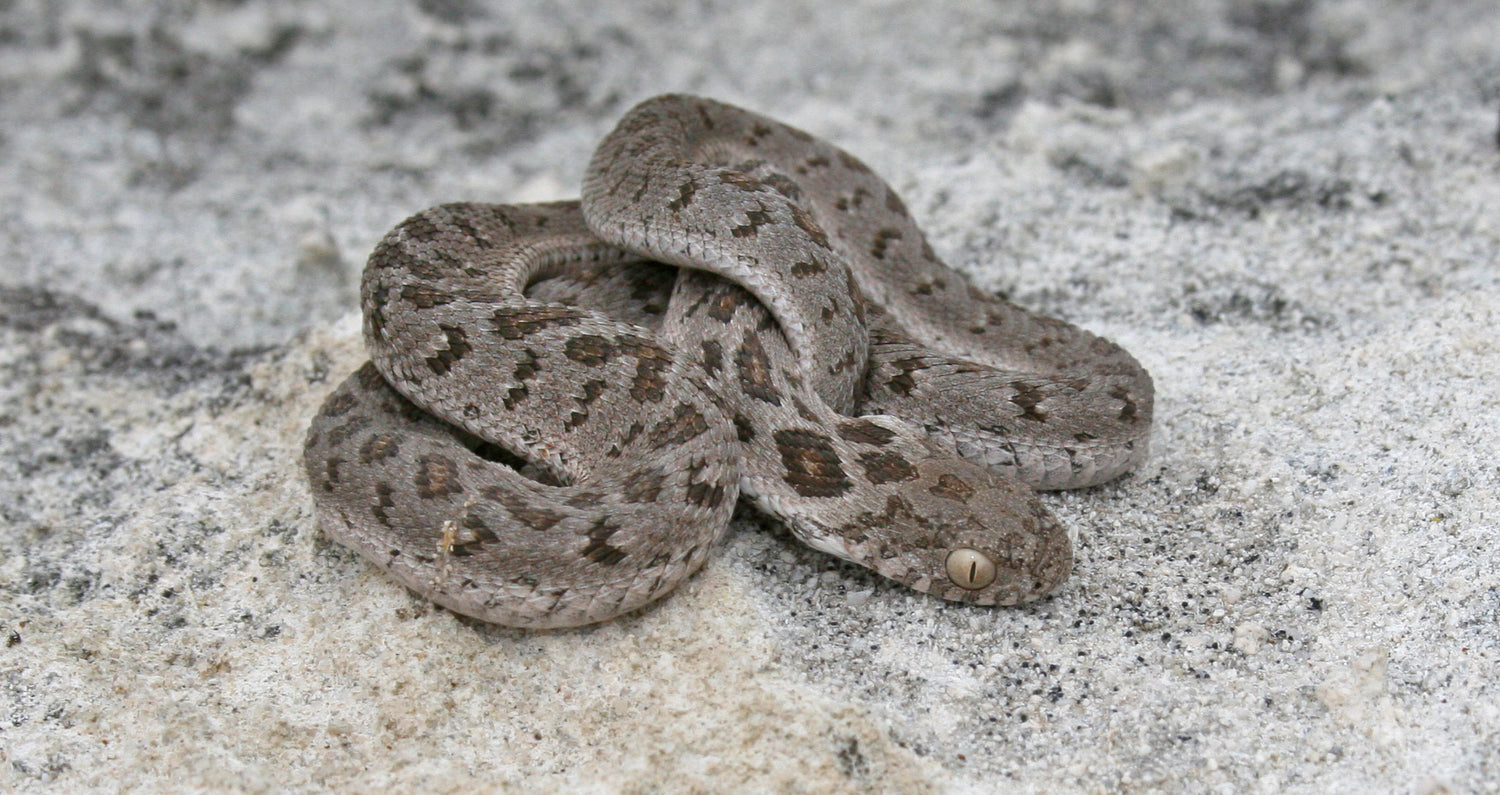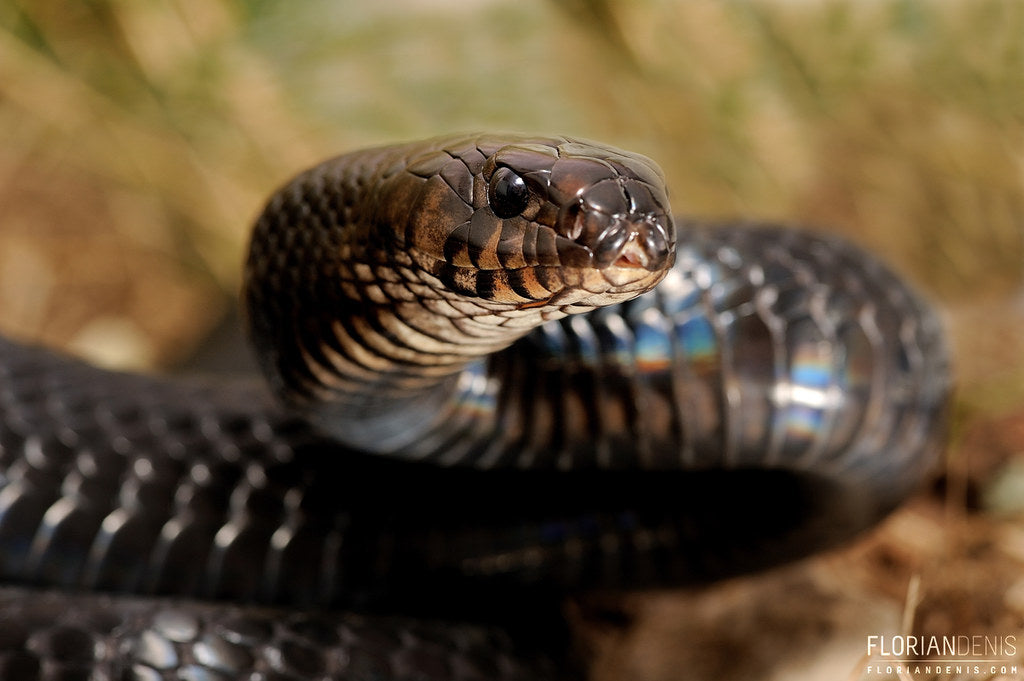Egg-eating snakes (Dasypeltis spp.) are a unique group of small, semi-arboreal, nocturnal snakes found primarily throughout sub-Saharan Africa. They have adapted to a wide variety of habitats depending on species, but particularly frequent forest and savannah areas.
Egg-eating snakes’ color and pattern varies based on species, but they are typically 24-48” long, with males being significantly smaller than females. They have a slender build, with a small rounded head, keeled scales, and large round eyes with vertical pupils.
Because of their particular dietary requirements, egg-eating snakes are a little more difficult to care for than other comparably-sized species. However, they are docile in nature and can make fascinating pets when their care needs are appropriately met.
How much space do egg-eating snakes need?
It’s easy to think of an egg-eating snake as smaller than it really is, keeping them in enclosures that are too small for them to stretch out fully and exercise. Given their length and semi-arboreal nature, the minimum for appropriately keeping one egg-eating snake is 36”L x 18”W x 36”H. This is just the minimum, so using larger dimensions is beneficial and will happily be used!
Cohabitation (keeping multiple egg eating snakes in one enclosure) is not recommended.
Do egg-eating snakes need UVB?
They can survive without it, but it’s still best practice to provide UVB lighting for optimal health and wellbeing. UVB gives snakes all of the vitamin D that their bodies need, stimulates better appetite and activity, and generally allows them to be healthier than they would be without.
The best UVB bulbs for egg-eating snakes are:
- Arcadia ShadeDweller UVB kit
- Zoo Med T8 Reptisun 5.0
The UVB bulb should be half the length of the enclosure, housed in a reflective fixture, and placed close to the heat lamp on top of the enclosure (over mesh), no closer than 8” above the basking area. UVB is blocked by glass and plastic, so you can’t give your snake UVB by placing its terrarium in front of an open window. Also make sure that the fixture your UVB bulb is in does not have a clear plastic bulb cover.
Lights should be on for at least 12 hours/day, or cycled seasonally 13 hours/day during summer and 11 hours/day during winter. This helps encourage more natural hormonal rhythms and better long-term health.
What basking temperatures do egg-eating snakes need?
Like other reptiles, egg-eating snakes are ectotherms, which means that they need a temperature gradient in their enclosure to help them regulate their metabolism and stay healthy.
Egg-eating snakes should have a basking temperature of 95-100°F. On the other side of the enclosure, the temperature should be between 72-82°F. Heating should be turned off at night, with temperatures dropping as low as 68°F. Track the temperatures in your enclosure with two digital probe thermometers — one placed on the basking surface, and one placed near the bottom of the enclosure.
Provide heat for your snake by imitating the sun with a halogen heat lamp or two, placed on one side of the enclosure, positioned over a sturdy basking branch. Do not use ceramic heat emitters (CHEs), red bulbs, or blue bulbs, as these are not as effective.
If the lamp(s) gets too hot, dial it down with a plug-in lamp dimmer or rheostat. If too cool, you will need higher-wattage bulbs.
What humidity levels do egg-eating snakes need?
Egg-eating snakes are highly adaptable to a variety of habitats with varying humidity levels, so here it’s important to pay attention to which species you’re keeping and the specific habitat they’re adapted to.
However, as a rule of thumb, aim for an average humidity of 40-60%, as measured by a digital probe hygrometer placed in the middle of the enclosure. There should also be a humid hide for your snake, lined with moistened sphagnum moss. Always having a humid retreat available is essential to having a well-hydrated snake.
Misting your snake’s enclosure with a sprayer each evening or every other day to help create the right humidity levels.
What substrate is good for egg-eating snakes?
Substrate helps make your enclosure more functional as well as more attractive. Ideally, the substrate that you use should resemble what the snakes naturally live on in the wild, and in the case of egg-eating snakes, that’s sand or sandy soil.
We recommend the following commercial substrates for egg-eating snakes:
- Zoo Med ReptiSoil
- Zoo Med ReptiSand
- Exo Terra Desert Sand
Alternatively, you can create your own substrate mix of 60% sand and 40% soil.
Substrate should be at least 2” deep and completely replaced every 3-4 months. Remove poop and urates daily, along with contaminated substrate.
What décor can you use in an egg-eating snake terrarium?
It’s terribly boring (and even stressful!) for a snake to be stuck in an enclosure with nothing in it except substrate, hides, and a water bowl. It doesn’t matter how big the enclosure is if you don’t put things in it for your pet to use and interact with.
Aside from hiding places, you will also need at least one branch for your snake to climb on, as well as some live or artificial foliage to provide cover. Additional options include:
- more branches
- cork flats and tubes
- ledges
- live or artificial plants
- leaf litter
What do egg-eating snakes eat?
Egg-eating snakes have a highly specialized diet: they are specifically evolved to eat eggs to get the nutrition that they need, and won’t eat anything else.
As a general schedule for feeding, aim to give your pet 1-2 appropriately-sized eggs per week. One appropriately-sized egg can be up to three times the size of your snake’s head. Eggs should be as fresh as possible and offered at room temperature.
Remember, the key to great nutrition is variety, even with egg-eating snakes! Although quail eggs are the general favorite with this species, it’s best to use different kinds of eggs for varied nutrition. Other options include button quail eggs, finch eggs, canary eggs, budgie eggs, and lovebird eggs. If you want an egg-eating snake for a pet, it’s best to be friends with a couple of people with female pet birds!
Water
Your snake should have access to clean, fresh water at all times. Provide a water bowl large enough for the snake to soak its entire body if desired. Change the water daily and scrub the bowl with a reptile-safe disinfectant weekly, or whenever it becomes soiled.
Do egg-eating snakes like to be handled?
Few reptiles actually “like” to be held, but egg-eating snakes generally tolerate handling well once they’ve settled in. This species very rarely bites. For best results, be gentle, and pick up the snake from below rather than from above. Avoid forcefully restraining them. Support as much of its body as possible, and NEVER pick up a snake by its tail!
*This care sheet contains only very basic information. Although it’s a good introduction, please do further research with high-quality sources to obtain additional information on caring for this species.
"Rhombic Egg Eater" by Mike Richardson and Sarah Winch is licensed under CC BY-NC-ND 2.0.




Leave a comment
This site is protected by hCaptcha and the hCaptcha Privacy Policy and Terms of Service apply.